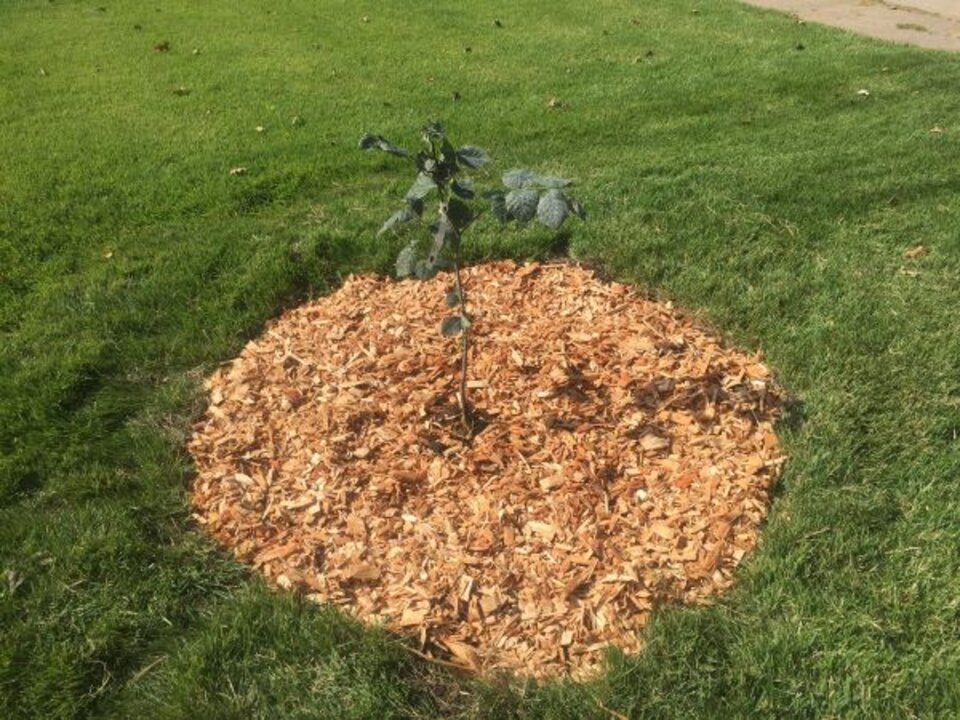Efficient and Effective Tree Watering

Drought conditions have led to stress in established trees and difficulty starting young trees. With the need for supplemental watering, correct irrigation practices are important to tree health and efficient water use.
Fall is tree planting time and an important time to water established trees in the absence of adequate precipitation. Whether a new tree or an established tree, correct watering is important. Too little as well as too much water can lead to tree stress, a decline in growth, and water waste.
Examples of incorrect watering are frequent, shallow irrigation such as from automatic systems; applying too much water at one time so it drains below the root zone and wastes water; waiting too long between irrigations; and not moistening a deep or wide enough area of a tree’s root zone.
Watering Trees
Deep and infrequent is the description used for correct watering of landscape plants. This means different things for different plants. Deep for turfgrass is 4 to 6 inches. Deep for a tree is 12 to 18 inches. Frequency varies with soil type, weather conditions, and site characteristics such as amount of shade and wind exposure. How often to water and how much is unique to each site.
For established trees that are healthy and well-sited, supplemental watering is usually not necessary when there is sufficient rainfall. During dry periods and drought, use an overhead sprinkler in a low pattern to moisten the soil 12 to 18 inches deep from near the trunk to just beyond the tree’s drip line. Using a soaker hose in a spiral pattern around the tree is also a good, often more efficient, method.
Once moistened deeply, wait until the upper six inches of soil is dry before watering again. Determine this by inserting a probe, i.e. screwdriver, into the soil. If it penetrates easily to the recommended depth and feels cool and moist when removed, moisture is likely not needed. Another method is using a spade or hand trowel to dig a small hole and feel the soil. If it feels cool and moist 6 inches deep, irrigation is not needed for established trees.
Where to Water
Tree roots grow outward from the trunk and the majority are in the upper 18 inches of soil where moisture, oxygen and nutrients are available. Roots can extend outward to a distance that is at least equal to the tree’s height. The larger the area watered, especially during drought, the better. As water conservation is important, the recommendation is to water to just outside the tree’s dripline as a way to save water.
For newly planted trees, these recommendations change some. It is still important to moisten the soil to the depth of the root ball or at least 12 inches deep. Since young trees do not have a broad crown and so there is a narrower space from the trunk to the drip line, moistening the soil outside the planting hole a few feet or more is important to promoting root growth into surrounding soil. Roots grow where water and oxygen are available in the soil.
Effective Watering Tips
According to Sarah Browning, Nebraska Extension Educator, a common mistake with tree watering is relying only on lawn irrigation with automatic systems. These systems often run too frequently and water shallow. Applying a light application of water daily or every other day results in a shallow layer of continuously saturated soil. This drives oxygen out of soil, resulting in severe root decline or death. Frequent, light applications of water is one of the most common causes of tree death.
Another common mistake made is not taking soil type into account. Browning says soil type is the greatest factor in watering frequency and amount. Sandy soils absorb water quickly and release it readily to plants, but the amount of water sandy soil can hold is low. Clay soils hold a lot of water, but absorb it slowly.
It is almost impossible to overwater trees in sandy soil, but water waste is more common. When too much water is applied to sandy soil it drains quickly through the soil and below the roots. Ideally, soil should be moist 18 inches deep for as long as the tree is growing. Watering every five to seven days may be necessary for trees in sandy soils to maintain adequate moisture when conditions are hot and windy.
Proper watering can be difficult in clay soils because water penetrates its' small pore spaces slowly. Water applied too quickly runs off and is wasted. However, once clay soils are wet they hold moisture for a longer time. Deep, infrequent applications of water are recommended for clay soils.
Efficient Watering Tips
To avoid water runoff, apply water slowly. When using an irrigation system, try the soak and cycle method. Cycle through your zones once using a run time short enough to stop irrigation before water starts to run off, then cycle through the zones a second time in the same day to achieve a deeper watering.
If using a hose and sprinkler, let it run in a low pattern in one area until the top 12 inches of soil is moistened then move it as needed to water the entire area from the trunk to just beyond the tree’s dripline. A deep soaking every two weeks should be adequate for most established trees in unirrigated landscapes.
Make sure trees and shrubs have a flat 3 to 4-inch layer of wood chip mulch around their base to hold in soil moisture and keep mowers or string trimmers away from their trunk. Do not pile the mulch against the trunk.
This article was reviewed by Sarah Browning